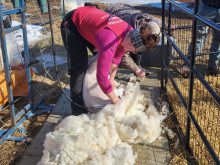Lamb producers and processors hope to earn $10 to $15 more for each lamb through more efficient marketing and production practices.
Tim Stolz, an Alberta member of a committee set up to explore value-added opportunities for the prairie lamb industry, said the idea is to increase the amount and quality of lamb available. He said an alliance of members from the production and processing chain would then target specific stores interested in that quality.
His committee hopes to have a proposal ready by the end of May.
Read Also

Charges laid after cattle theft
Saskatchewan RCMP lay two charges against a man after six cattle went missing.
Producers from Alberta and Saskatchewan, as well as representatives from the Canadian Sheep Federation and Sunterra Meats, are involved.
Sunterra president Ray Price said producers and processors have to better understand how each sector works and how they could work together.
For example, Sunterra has trouble finding a consistent supply of quality lambs.
“We recognize that producers have difficulty lambing out of season and things like that,” Price said, but the company must satisfy its consumers’ needs.
Producers say it’s more expensive to lamb out of season, but Price said the company could sit down with a group and discuss what premiums might be available if they did lamb at a different time.
“It’s about an honest sharing of information,” he said.
Gordon Schroeder, executive director of the Saskatchewan Sheep Development Board, told a recent producer meeting in Moose Jaw, Sask., that those who participate in a value chain have to be patient and willing to follow agreed upon specifications.
Chains could be built on genetics, weight, feeding systems or combinations of factors.
Not all producers will fit a particular chain.
Schroeder is general manager of Canadian Prairie Lamb, which was formed in 2003 to add value to lamb cuts that don’t move as well as chops and racks.
The group has struggled to find adequate processing.
“Canadian Prairie Lamb is a component of what our industry needs,” Schroeder said.
It could fit into a value chain with producers and Sunterra.
Price said one producer at the meeting pointed out people have been talking about value chains for years without any concrete results.
He said sharing information is the first step, and the industry won’t be worse off even if the idea stalls.
“Part of our frustration is that production has been quite profitable but we haven’t seen expansion,” Price added.
Recent Statistics Canada numbers suggested flock size dropped to 808,200 from 825,300 as of Jan. 1, although numbers have gone up in several provinces including Alberta and British Columbia.

















